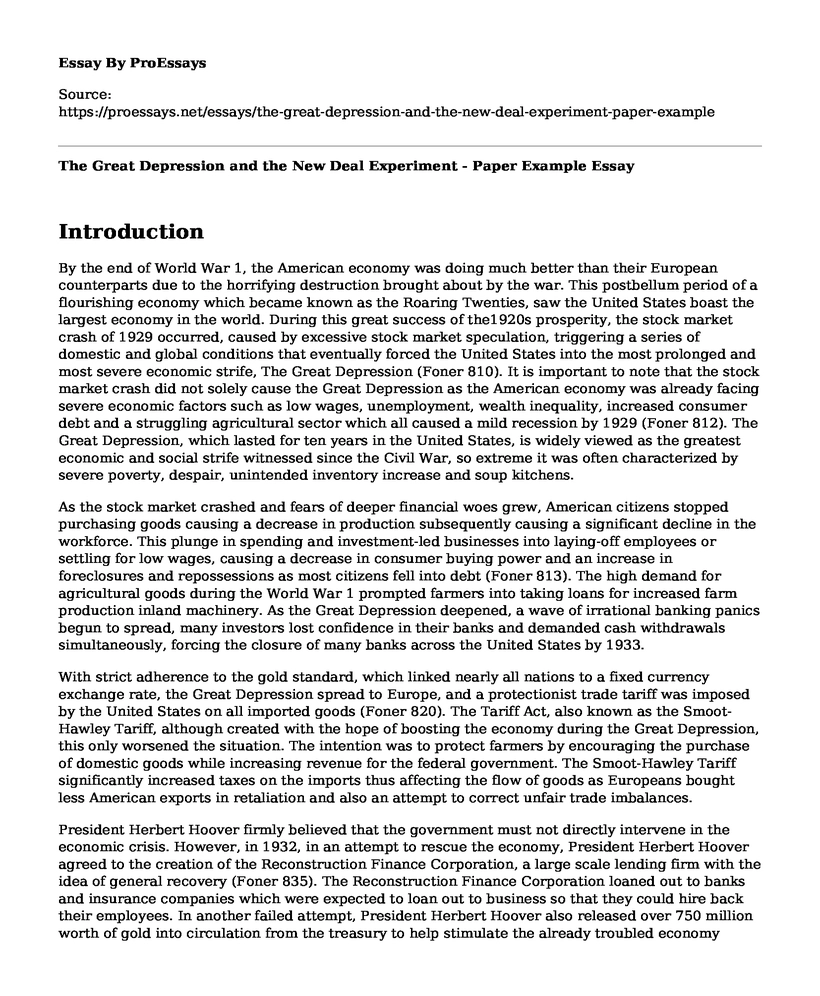Introduction
By the end of World War 1, the American economy was doing much better than their European counterparts due to the horrifying destruction brought about by the war. This postbellum period of a flourishing economy which became known as the Roaring Twenties, saw the United States boast the largest economy in the world. During this great success of the1920s prosperity, the stock market crash of 1929 occurred, caused by excessive stock market speculation, triggering a series of domestic and global conditions that eventually forced the United States into the most prolonged and most severe economic strife, The Great Depression (Foner 810). It is important to note that the stock market crash did not solely cause the Great Depression as the American economy was already facing severe economic factors such as low wages, unemployment, wealth inequality, increased consumer debt and a struggling agricultural sector which all caused a mild recession by 1929 (Foner 812). The Great Depression, which lasted for ten years in the United States, is widely viewed as the greatest economic and social strife witnessed since the Civil War, so extreme it was often characterized by severe poverty, despair, unintended inventory increase and soup kitchens.
As the stock market crashed and fears of deeper financial woes grew, American citizens stopped purchasing goods causing a decrease in production subsequently causing a significant decline in the workforce. This plunge in spending and investment-led businesses into laying-off employees or settling for low wages, causing a decrease in consumer buying power and an increase in foreclosures and repossessions as most citizens fell into debt (Foner 813). The high demand for agricultural goods during the World War 1 prompted farmers into taking loans for increased farm production inland machinery. As the Great Depression deepened, a wave of irrational banking panics begun to spread, many investors lost confidence in their banks and demanded cash withdrawals simultaneously, forcing the closure of many banks across the United States by 1933.
With strict adherence to the gold standard, which linked nearly all nations to a fixed currency exchange rate, the Great Depression spread to Europe, and a protectionist trade tariff was imposed by the United States on all imported goods (Foner 820). The Tariff Act, also known as the Smoot-Hawley Tariff, although created with the hope of boosting the economy during the Great Depression, this only worsened the situation. The intention was to protect farmers by encouraging the purchase of domestic goods while increasing revenue for the federal government. The Smoot-Hawley Tariff significantly increased taxes on the imports thus affecting the flow of goods as Europeans bought less American exports in retaliation and also an attempt to correct unfair trade imbalances.
President Herbert Hoover firmly believed that the government must not directly intervene in the economic crisis. However, in 1932, in an attempt to rescue the economy, President Herbert Hoover agreed to the creation of the Reconstruction Finance Corporation, a large scale lending firm with the idea of general recovery (Foner 835). The Reconstruction Finance Corporation loaned out to banks and insurance companies which were expected to loan out to business so that they could hire back their employees. In another failed attempt, President Herbert Hoover also released over 750 million worth of gold into circulation from the treasury to help stimulate the already troubled economy (Foner 845). The Federal Home Bank Loans Act helped create savings and loans institutions and increased borrowings for home ownership to Americans. President Herbert Hoover explored many ways to lift the ailing economy but was reluctant with direct federal involvement. He feared that a federal relief program would undermine the efforts of local governments and philanthropic organizations. President Herbert is known for famously blaming Mexicans for the economic downturn. He championed a mass forced migration of Mexicans in what became known as The Mexican Repatriation Program.
Work Cited
Foner, Eric. "From Business Culture to the Great Depression: The Twenties, 1920-1932."
Give Me Liberty! An American History: Fifth Edition. Vol. 2. WW Norton & Company, 2017.
Foner, Eric. "The New Deal, 1932-1940." Give Me Liberty! An American History: Fifth Edition. Vol. 2. WW Norton & Company, 2017.
Foner, Eric. "Voices of Freedom: A Documentary History (Vol. 1)."
Cite this page
The Great Depression and the New Deal Experiment - Paper Example. (2022, Jun 30). Retrieved from https://proessays.net/essays/the-great-depression-and-the-new-deal-experiment-paper-example
If you are the original author of this essay and no longer wish to have it published on the ProEssays website, please click below to request its removal:
- Research Paper on Egypt Civilization
- Spartan and Athenian Archaic Societies by Using Plutarch's Life of Lycurgus and Life of Solon
- Essay Sample on 19th-Century Americans: Worries Over Volatility, Slavery, and Legacy
- Essay Sample on the War Between the Evil and the Divine Within: Exploring Truth, Sight, and Vision
- Essay Sample on Young African American Women: Misogyny and Slavery
- Essay Sample on Civil War Ends With Robert E. Lee's Last Attempt at Gettysburg
- Karl Marx Analytics - Essay Sample







